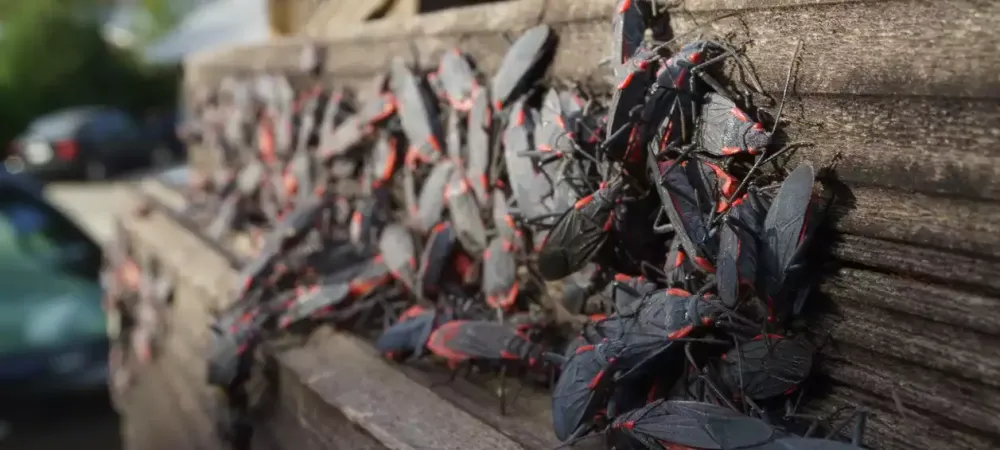What Kills Box Elder Beetles?

Box elder beetles are a common nuisance in Michigan homes, especially during the fall and early spring. This guide will provide Michigan homeowners with a thorough understanding of these pests, including their appearance, potential dangers, reasons for their presence, and effective methods for removal.
What Are Box Elder Beetles?
Box elder beetles (Boisea trivittata) are small insects, approximately 1/2 inch long, with a black body and orange or red markings. They have three distinct orange or red stripes running down the center of their back, with their legs and antennae also exhibiting orange or red highlights. Their wings are folded in an X-pattern over their abdomen.
Box elder beetles are known for their tendency to congregate in large numbers on warm, sunlit surfaces, especially during the fall and spring as they seek shelter. They feed on the seeds and leaves of box elder trees and can occasionally cause minor damage to these trees. While they are not harmful to humans or pets and do not bite or sting, their presence can be a nuisance, particularly when they invade homes looking for a place to overwinter.
How to Get Rid of Box Elder Beetles in Michigan
Box elder beetles can be a persistent problem for Michigan homeowners, especially as they seek shelter from the cold. To effectively manage and eliminate these pests, here’s a comprehensive guide tailored specifically for Michigan residents.
1. Identify and Seal Entry Points
In Michigan, box elder beetles commonly invade homes to escape the state’s harsh winter. Sealing entry points helps prevent them from getting inside.
- Inspect Your Home: Check for gaps around windows, doors, vents, and foundation. Pay close attention to areas where exterior siding meets the foundation.
- Seal Cracks and Gaps: Use caulk, expanding foam, and/or mesh to seal any cracks or gaps.
- Weatherstripping: Ensure that all doors and windows are properly sealed by installing weatherstripping on all exterior doors and windows.
- Repair Screens: Ensure that window and door screens are intact and properly fitted.
2. Consider Removing Box Elder Trees
Box elder trees are a primary attractant for box elder beetles. If feasible, remove or relocate box elder trees from close proximity to your home to reduce the beetles’ attraction to your property. Identify box elder trees near your home. In Michigan, these trees are often found in yards and parks.
If removing the tree is not feasible, consult with a local arborist to discuss trimming or treatment options.
3. Use Chemical Treatments
Chemical treatments can provide immediate control of box elder beetles that have already entered your home or are congregating around entry points.
- Insecticide Sprays: In Michigan, you can find insecticides specifically formulated for box elder beetles. Products containing permethrin or bifenthrin can be used to treat areas where beetles are found.
- Contact Insecticides: Insecticides that kill on contact can be effective for immediate control. Look for products labeled for box elder beetles and follow application instructions carefully.
- Residual Sprays: Apply residual sprays around potential entry points like window sills, door frames, and cracks where beetles are commonly seen. These sprays remain effective for weeks, killing beetles that come into contact with the treated surfaces.
Always use insecticides according to the label instructions and safety precautions. If in doubt, consider hiring a professional pest control service in Michigan.
4. Implement Natural Remedies
Natural remedies provide environmentally friendly options for managing box elder beetles and can be useful for ongoing prevention.
- Manual Removal: Use a vacuum cleaner to remove beetles from surfaces. Empty the vacuum bag or canister outside immediately to prevent the beetles from re-entering the home.
- Natural Powder: Diatomaceous earth is a natural, non-toxic powder that can be sprinkled around entry points. It works by dehydrating insects that come into contact with it.
- DIY Soap and Water Solution: Mix water with a few tablespoons of liquid dish soap and spray it directly onto box elder beetles. This solution helps to suffocate the insects.
- Essential Oils: Certain essential oils, such as peppermint or eucalyptus, can be used to repel box elder beetles. Mix a few drops with water and spray around entry points.
Regular Cleaning and Maintenance
Maintaining a clean environment helps prevent the attraction of box elder beetles and other pests.
- Vacuum Regularly: Use a vacuum to remove beetles from surfaces. Dispose of the vacuum bag or contents outside to prevent re-entry.
- Remove Debris: Keep your yard and home free of plant debris that may attract pests.
5. Consult Local Pest Control Professionals
Box elder beetles can be a significant nuisance for Michigan homeowners, particularly during colder months when they seek indoor refuge. For severe infestations or if you need tailored solutions, local pest control professionals in Michigan can provide specialized treatments and advice. All Seasons Pest Control has 39 years of local experience and offers comprehensive pest solutions tailored to your specific needs. Contact our team today!
FAQ About Getting Rid of Box Elder Beetles
Are Box Elder Beetles Dangerous?
Box elder beetles are not harmful to humans or pets. They do not bite or sting, and they are not known to spread diseases. However, their presence can be a nuisance, particularly when they invade homes in large numbers. They can also cause minor damage to plants and trees by feeding on the sap.
Why Are Box Elder Beetles in My Michigan House?
Box elder beetles are attracted to the warmth of homes, especially in the fall and spring when they seek shelter for overwintering. They often enter through small cracks and crevices in walls, windows, or doors. Michigan's cold winters drive these beetles to seek indoor refuge where they can stay warm and protected.
What Attracts Box Elder Beetles?
In Michigan, box elder beetles are primarily attracted to box elder trees, which serve as their main food source and breeding ground. As temperatures drop, they seek warmth and shelter in homes, often entering through cracks and gaps around windows, doors, and vents. Sunlit surfaces and warm areas, such as south-facing walls, also draw them in, providing a cozy spot to bask. Additionally, nearby plants, leaf litter, and other debris can offer additional shelter and food. To deter these beetles, it's essential to remove or relocate box elder trees, seal entry points, clean up yard debris, and ensure proper insulation and barriers around your home.



